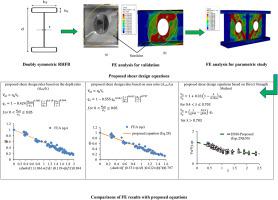Journal of Constructional Steel Research ( IF 4.0 ) Pub Date : 2021-07-15 , DOI: 10.1016/j.jcsr.2021.106836 Dinesh Lakshmanan Chandramohan 1 , Elilarasi Kanthasamy 2 , Perampalam Gatheeshgar 2 , Keerthan Poologanathan 2 , Muhammadh Fareedh Muhammadh Ishqy 3 , Thadshajini Suntharalingam 2 , Thirunavukkarasu Kajaharan 4

|
Cold-Formed Steel (CFS) sections are extensively used in structural engineering applications replacing the conventional hot-rolled sections due to their inherent advantages. Web openings are generally placed in CFS floor joists and bearers to accommodate the building services, which leads the reduction of floor height. The web openings significantly influence the shear behaviour and reduce the shear capacity. However, very limited research studies have been conducted on hollow flange CFS beams with web openings under shear load. Therefore, this study presents a detailed Finite Element (FE) investigation of the shear behaviour of CFS doubly symmetric Rectangular Hollow Flange Beams (RHFBs) with unreinforced circular web openings. Non-linear FE models were created and validated using the laboratory shear test results. A detailed parametric study was then carried out by extending the validated FE models for doubly symmetric RHFBs with circular web openings. In total,126 FE models were investigated with different geometric parameters including section depth, thickness, material strength and web opening sizes to observe their behaviour on shear strength. The results showed that the existing shear strength design equations are either unsafe or conservative for doubly symmetric RHFBs with unreinforced circular web openings. Therefore, new Direct Strength Method (DSM) based shear design rules are proposed to estimate the shear strength of doubly symmetric RHFBs with unreinforced circular web openings in conjunction with proposed shear reduction factor (qs).
中文翻译:

腹板开孔双对称空心翼缘梁的剪切特性与设计
冷弯型钢 (CFS) 型材因其固有的优势而被广泛用于结构工程应用,以取代传统的热轧型材。腹板开口通常放置在 CFS 地板托梁和承载物中以容纳建筑服务,从而导致地板高度的降低。腹板开口显着影响剪切行为并降低剪切能力。然而,对在剪切载荷下具有腹板开口的空心翼缘 CFS 梁进行的研究非常有限。因此,本研究对具有未增强圆形腹板开口的 CFS 双对称矩形空心法兰梁 (RHFB) 的剪切行为进行了详细的有限元 (FE) 研究。非线性有限元模型是使用实验室剪切测试结果创建和验证的。然后通过扩展具有圆形腹板开口的双对称 RHFB 的验证有限元模型进行详细的参数研究。总共研究了 126 个具有不同几何参数的有限元模型,包括截面深度、厚度、材料强度和腹板开口尺寸,以观察它们对剪切强度的行为。结果表明,现有的抗剪强度设计方程对于具有无钢筋圆形腹板开口的双对称 RHFBs 要么不安全,要么保守。因此,提出了新的基于直接强度法 (DSM) 的剪切设计规则,以结合建议的剪切折减系数 (q) 来估计具有无钢筋圆形腹板开口的双对称 RHFB 的剪切强度 总共研究了 126 个具有不同几何参数的有限元模型,包括截面深度、厚度、材料强度和腹板开口尺寸,以观察它们对剪切强度的行为。结果表明,现有的抗剪强度设计方程对于具有无钢筋圆形腹板开口的双对称 RHFBs 要么不安全,要么保守。因此,提出了新的基于直接强度法 (DSM) 的剪切设计规则,以结合建议的剪切折减系数 (q) 来估计具有无钢筋圆形腹板开口的双对称 RHFB 的剪切强度 总共研究了 126 个具有不同几何参数的有限元模型,包括截面深度、厚度、材料强度和腹板开口尺寸,以观察它们对剪切强度的行为。结果表明,现有的抗剪强度设计方程对于具有无钢筋圆形腹板开口的双对称 RHFBs 要么不安全,要么保守。因此,提出了新的基于直接强度法 (DSM) 的剪切设计规则,以结合建议的剪切折减系数 (q) 来估计具有无钢筋圆形腹板开口的双对称 RHFB 的剪切强度 结果表明,现有的抗剪强度设计方程对于具有无钢筋圆形腹板开口的双对称 RHFBs 要么不安全,要么保守。因此,提出了新的基于直接强度法 (DSM) 的剪切设计规则,以结合建议的剪切折减系数 (q) 来估计具有无钢筋圆形腹板开口的双对称 RHFB 的剪切强度 结果表明,现有的抗剪强度设计方程对于具有无钢筋圆形腹板开口的双对称 RHFBs 要么不安全,要么保守。因此,提出了新的基于直接强度法 (DSM) 的剪切设计规则,以结合建议的剪切折减系数 (q) 来估计具有无钢筋圆形腹板开口的双对称 RHFB 的剪切强度s )。

































 京公网安备 11010802027423号
京公网安备 11010802027423号